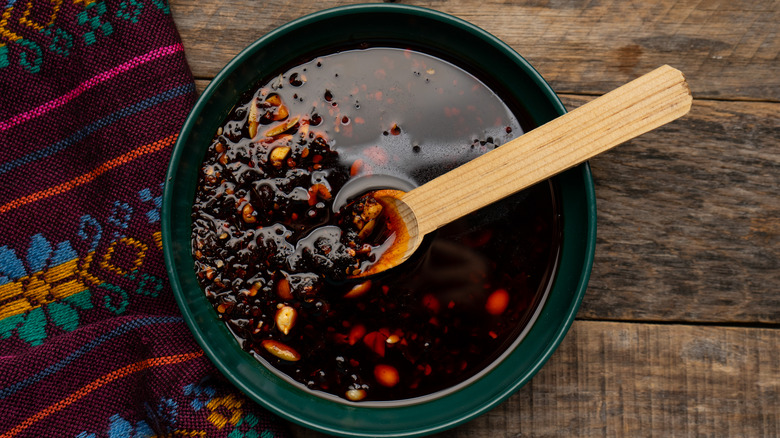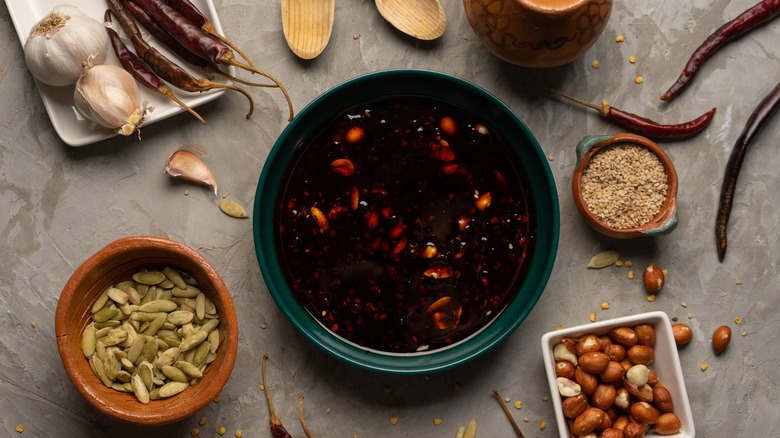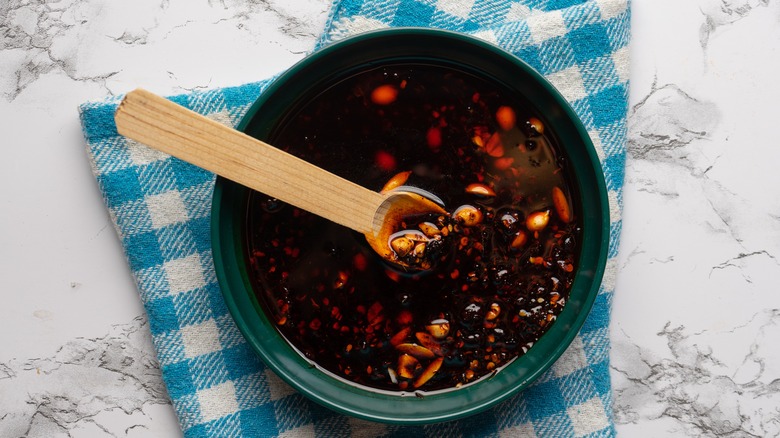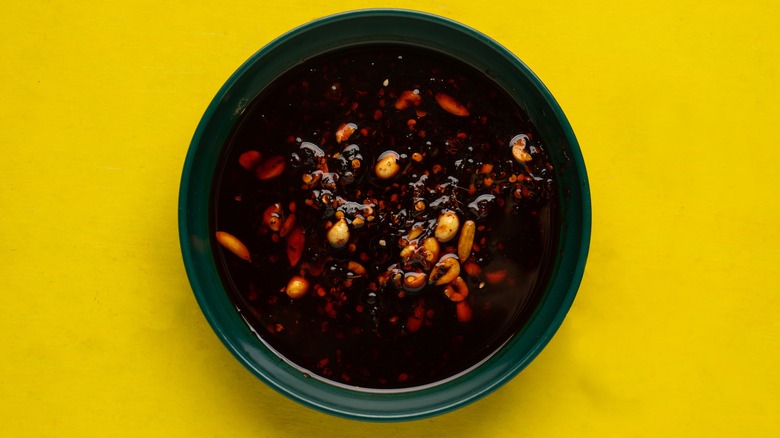What Makes Salsa Macha Unique?
Salsa is simply Spanish for sauce, so while the beloved tomato and chili variety may be the first version that comes to mind, it's only a dip into a wide array of recipes. From fruity chopped pineapple or mango salsa to creamy and herbal salsa de aguacate, the condiment can shift through many forms. Few are more malleable than salsa macha — a tomato-less, chili oil type.
Loaded with nuts, dried peppers, garlic, and spices, salsa macha resembles Asian chili oils, but with a uniquely Mexican palate. It comes in forms that range from earthy and mild to bright and spicy, but it's always dependably savory and balanced — a quality that makes it easy to integrate into dishes. Plus, it has a remarkably stable shelf life since it doesn't utilize fresh produce.
Popular in the Mexican states of Veracruz and Oaxaca for centuries, salsa macha is now becoming the hot new condiment in the U.S. Celebrated chefs are crafting creative renditions, and big brands are concocting jars that are hitting grocery store shelves. Just a drizzle makes it easy to see why this condiment is so trendy — let's dive into what it's all about.
History of salsa macha
The origins of this tomato-less salsa interlink with the mountainous town of Orizaba, located in Mexico's eastern Veracruz state. Here, indigenous Totonac people traditionally created a paste with dried chilies, sesame seeds, and salt, ground to a fine consistency in a molcajete.
Who added the oil is unknown — some speculate Veracuz natives submerged the spices in palm oil. Others suggest the influence may be international, proposing that salsa macha's resemblance to Asian chili oil is more than coincidental.
The nearby port of Veracruz, founded by the Spanish in 1519, was a bustling hub for global arrivals. Perhaps an Asian-Mexican culinary exchange took place in Veracruz — although there are no historical documents to back up the claim.
Salsa macha is also commonly prepared in the state of Oaxaca, where there is a multitude of regional oil-based salsa variants. Nowadays, salsa is experiencing a surge in popularity all across North America, with many reinterpretations. Let's look at the typical ingredients.
Ingredients in salsa macha
The salsa's delicious paste-like texture arises due to a nut base. Peanuts are the most popular choice, with their high-oil content and ubiquity well-geared to salsa macha. Sesame seeds are another common addition, often used in combination or as a sole foundation. Further deviations include sunflower seeds, cashews, and almonds –a large part of the salsa's beauty is its malleability.
Of course, there's no salsa without peppers, and salsa macha relies exclusively on dried chilies. Ancho peppers are the most frequent ingredient, their earthy flavor well-suited to an oil base. For a dash of heat, chefs frequently add the slender Árbol chilies, which introduce a brighter note to the mix. Of course, these two peppers are just a launching point — morita, chipotle, and guajillo peppers are just a sampling of other peppers added to salsa macha. The spice level of the chili oil is highly variable, but like most salsas, it tends to run spicy.
In combination with the peppers, garlic is central to salsa macha, its earthiness accentuating the ancho peppers. An acidic balance comes through apple cider vinegar, although not all recipes involve a sour component. From there, final flavorings are dependent on local recipes and preferences — dried oregano, brown sugar, cacao, and even coffee are a morsel of possibilities.
And finally, salsa macha requires oil to tie everything together. Neutral, high-heat cooking oils are favored, with especially grapeseed a popular choice. Vegetables, sunflower, and peanut oil also get the job done.
How salsa macha is prepared
While most salsas rely on fresh ingredients to create vibrant flavors, salsa macha instead utilizes hot oil to bring out fragrant aromas of peppers and spices. First, the nut base is toasted alongside garlic in the oil, which is then poured over the chilies. After around a minute of bathing in the hot mixture, the peppers expand — blooming into the desired flavor for the salsa.
Additional flavors like vinegar and sugar are added before the resultant mixture is blended to completion. It's essential the oil temperature is carefully monitored — it should be allowed to cool before pouring over the peppers, or else overly burnt flavors may result.
Salsa macha's consistency differs among varying recipes. In the traditional, more labor-intensive method, the toasted ingredients are pulverized in a molcajete. Utilizing hand-grinding allows for more deft control of the resultant texture, with oil slowly added until a desired consistency is achieved. Some also add the nuts after grinding to achieve a more heterogenous consistency.
Such a range of textures is part of salsa macha's beauty, as an oil base allows for greater experimentation than with tomatoes. Plus, the salsa is much more stable — safe for consumption for several months without refrigeration.
How is salsa macha served?
Oily, fragrant, and earthy, salsa macha is one of the most versatile condiments. In Mexico, it's a tableside salsa drizzled on just about any dish — tacos, burritos, quesadillas, tortas, grilled meats, and more. It also goes especially well with eggs, whether it's a quick and easy morning scramble or heartier huevos rancheros. Plus, it can be a key component in a light meal of its own, deliciously meshing with only an avocado atop a crispy tostada.
And in comparison to other salsa, this chili oil is more malleable with non-Mexican foods. Consider dressing a rotisserie chicken, a salad, or even adding a kick to a bowl of vanilla ice cream with salsa macha. Plus, it's similar in flavor to Asian chili oil, so it can be used as a substitute — whether it's in a noodle bowl or as a drizzle on top of crispy tofu. The sky is the limit for applications, and such quality makes it stand apart from the rest.




